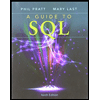
Computer Science: An Overview (12th Edition)
12th Edition
ISBN: 9780133760064
Author: Glenn Brookshear, Dennis Brylow
Publisher: PEARSON
expand_more
expand_more
format_list_bulleted
Question
Chapter 9.2, Problem 6QE
Program Plan Intro
Relational
It is a method to manage the data by using a structure and language that is consistent with the first-order predicate logic. The main aim of the relational model is to provide the declarative method for selected data and queries directly to the clients.
Expert Solution & Answer
Want to see the full answer?
Check out a sample textbook solution
Students have asked these similar questions
Dijkstra's Algorithm (part 1). Consider the network shown below, and Dijkstra’s link-state algorithm. Here, we are interested in computing the least cost path from node E (note: the start node here is E) to all other nodes using Dijkstra's algorithm. Using the algorithm statement used in the textbook and its visual representation, complete the "Step 0" row in the table below showing the link state algorithm’s execution by matching the table entries (i), (ii), (iii), and (iv) with their values. Write down your final [correct] answer, as you‘ll need it for the next question.
4. |z + 5 - 5i| = 7
14.
dz,
C: |z❘
C: |z❘ = 0.6
ze² - 2iz
H
Chapter 9 Solutions
Computer Science: An Overview (12th Edition)
Ch. 9.1 - Identify two departments in a manufacturing plant...Ch. 9.1 - Prob. 2QECh. 9.1 - Summarize the roles of the application software...Ch. 9.2 - Prob. 1QECh. 9.2 - Prob. 2QECh. 9.2 - Prob. 4QECh. 9.2 - Prob. 5QECh. 9.2 - Prob. 6QECh. 9.3 - Prob. 1QECh. 9.3 - What is a persistent object?
Ch. 9.3 - Identify some classes as well as some of their...Ch. 9.3 - Prob. 4QECh. 9.4 - Prob. 1QECh. 9.4 - Prob. 2QECh. 9.4 - Prob. 3QECh. 9.4 - Prob. 4QECh. 9.4 - Prob. 5QECh. 9.4 - Prob. 6QECh. 9.5 - Prob. 1QECh. 9.5 - Prob. 2QECh. 9.5 - Prob. 3QECh. 9.5 - Prob. 4QECh. 9.5 - Prob. 5QECh. 9.5 - Prob. 6QECh. 9.5 - Prob. 7QECh. 9.6 - Prob. 1QECh. 9.6 - Give an additional example of a pattern that might...Ch. 9.6 - Prob. 3QECh. 9.6 - How does data mining differ from traditional...Ch. 9.7 - Prob. 1QECh. 9.7 - Prob. 2QECh. 9.7 - Prob. 3QECh. 9.7 - Prob. 4QECh. 9 - Prob. 1CRPCh. 9 - Prob. 2CRPCh. 9 - Prob. 3CRPCh. 9 - Prob. 4CRPCh. 9 - Prob. 5CRPCh. 9 - Prob. 6CRPCh. 9 - Prob. 7CRPCh. 9 - Prob. 8CRPCh. 9 - Prob. 9CRPCh. 9 - Prob. 10CRPCh. 9 - Prob. 11CRPCh. 9 - Prob. 12CRPCh. 9 - Using the commands SELECT, PROJECT, and JOIN,...Ch. 9 - Answer Problem 13 using SQL. PROBLEM 13 13. Using...Ch. 9 - Prob. 15CRPCh. 9 - Prob. 16CRPCh. 9 - Prob. 17CRPCh. 9 - Prob. 18CRPCh. 9 - Prob. 19CRPCh. 9 - Empl Id Name Address SSN Job Id Job Title Skill...Ch. 9 - Empl Id Name Address SSN Job Id Job Title Skill...Ch. 9 - Prob. 22CRPCh. 9 - Prob. 23CRPCh. 9 - Prob. 24CRPCh. 9 - Prob. 25CRPCh. 9 - Write a sequence of instructions (using the...Ch. 9 - Prob. 27CRPCh. 9 - Prob. 28CRPCh. 9 - Prob. 29CRPCh. 9 - Prob. 30CRPCh. 9 - Prob. 31CRPCh. 9 - Prob. 32CRPCh. 9 - Prob. 33CRPCh. 9 - Prob. 34CRPCh. 9 - Prob. 35CRPCh. 9 - Prob. 36CRPCh. 9 - Prob. 37CRPCh. 9 - Prob. 38CRPCh. 9 - Prob. 39CRPCh. 9 - Prob. 40CRPCh. 9 - Prob. 41CRPCh. 9 - Prob. 42CRPCh. 9 - Prob. 43CRPCh. 9 - Prob. 44CRPCh. 9 - Prob. 45CRPCh. 9 - Prob. 46CRPCh. 9 - Prob. 47CRPCh. 9 - Prob. 48CRPCh. 9 - Prob. 49CRPCh. 9 - Prob. 50CRPCh. 9 - Prob. 51CRPCh. 9 - Prob. 52CRPCh. 9 - Prob. 53CRPCh. 9 - Prob. 54CRPCh. 9 - Prob. 55CRPCh. 9 - Prob. 56CRPCh. 9 - Prob. 57CRPCh. 9 - Prob. 58CRPCh. 9 - Prob. 59CRPCh. 9 - Prob. 60CRPCh. 9 - Prob. 61CRPCh. 9 - Prob. 62CRPCh. 9 - Prob. 1SICh. 9 - Prob. 2SICh. 9 - Prob. 3SICh. 9 - Prob. 4SICh. 9 - Prob. 5SICh. 9 - Prob. 6SICh. 9 - Prob. 7SICh. 9 - Prob. 8SICh. 9 - Prob. 9SICh. 9 - Prob. 10SI
Knowledge Booster
Similar questions
arrow_back_ios
SEE MORE QUESTIONS
arrow_forward_ios
Recommended textbooks for you
 Principles of Information Systems (MindTap Course...Computer ScienceISBN:9781305971776Author:Ralph Stair, George ReynoldsPublisher:Cengage Learning
Principles of Information Systems (MindTap Course...Computer ScienceISBN:9781305971776Author:Ralph Stair, George ReynoldsPublisher:Cengage Learning
 Enhanced Discovering Computers 2017 (Shelly Cashm...Computer ScienceISBN:9781305657458Author:Misty E. Vermaat, Susan L. Sebok, Steven M. Freund, Mark Frydenberg, Jennifer T. CampbellPublisher:Cengage Learning
Enhanced Discovering Computers 2017 (Shelly Cashm...Computer ScienceISBN:9781305657458Author:Misty E. Vermaat, Susan L. Sebok, Steven M. Freund, Mark Frydenberg, Jennifer T. CampbellPublisher:Cengage Learning Principles of Information Systems (MindTap Course...Computer ScienceISBN:9781285867168Author:Ralph Stair, George ReynoldsPublisher:Cengage Learning
Principles of Information Systems (MindTap Course...Computer ScienceISBN:9781285867168Author:Ralph Stair, George ReynoldsPublisher:Cengage Learning A Guide to SQLComputer ScienceISBN:9781111527273Author:Philip J. PrattPublisher:Course Technology Ptr
A Guide to SQLComputer ScienceISBN:9781111527273Author:Philip J. PrattPublisher:Course Technology Ptr Database Systems: Design, Implementation, & Manag...Computer ScienceISBN:9781305627482Author:Carlos Coronel, Steven MorrisPublisher:Cengage Learning
Database Systems: Design, Implementation, & Manag...Computer ScienceISBN:9781305627482Author:Carlos Coronel, Steven MorrisPublisher:Cengage Learning

Principles of Information Systems (MindTap Course...
Computer Science
ISBN:9781305971776
Author:Ralph Stair, George Reynolds
Publisher:Cengage Learning


Enhanced Discovering Computers 2017 (Shelly Cashm...
Computer Science
ISBN:9781305657458
Author:Misty E. Vermaat, Susan L. Sebok, Steven M. Freund, Mark Frydenberg, Jennifer T. Campbell
Publisher:Cengage Learning

Principles of Information Systems (MindTap Course...
Computer Science
ISBN:9781285867168
Author:Ralph Stair, George Reynolds
Publisher:Cengage Learning

A Guide to SQL
Computer Science
ISBN:9781111527273
Author:Philip J. Pratt
Publisher:Course Technology Ptr

Database Systems: Design, Implementation, & Manag...
Computer Science
ISBN:9781305627482
Author:Carlos Coronel, Steven Morris
Publisher:Cengage Learning